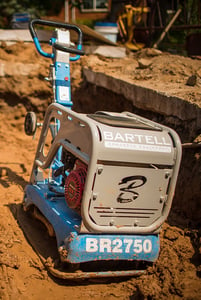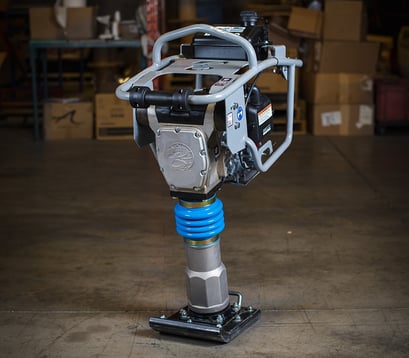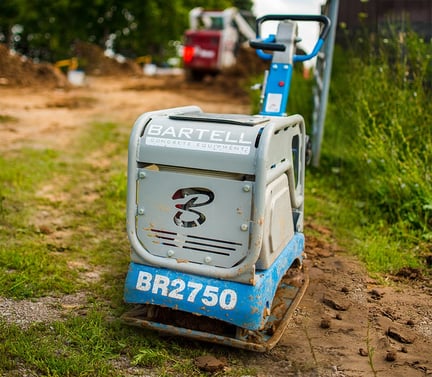Compaction is one of the most important steps for many construction projects. A properly compacted base will ensure the stability needed to properly support structures, sidewalks, roadways etc.
To see all of our Plate Compactor models in detail, Click Here
Depending on the size or type of job, there are a few different compaction options to choose from, such as vibratory plate compactors, and tamping rammers (otherwise known as a jumping jack). Although the tools used, and compaction requirements may differ by job, the intended outcome is the same; creating a strong stable base that will reduce the severity of settlement, increase resistance, and limits excessive and unwanted movement and volume changes of the soil.
 Like stated above, there are different equipment options available, and choosing the right one for the job at hand, is crucial.
Like stated above, there are different equipment options available, and choosing the right one for the job at hand, is crucial.
The two most common pieces of equipment for general contracting, that we receive the most questions about are rammers and plate compactors. We’ve found that people aren’t always sure when one may be a better option over the other. Below, we’ll discuss and highlight what you’ll need to take into consideration when choosing between the two.
SOIL TYPES
When choosing between a plate compactor and rammer, it’s important to understand the differences between the soil types. This will help you to determine the type of equipment you’ll need to use to achieve the best results.
Typically there are 2 different soil types:
- Granular
- Cohesive
Granular Soils, like gravel and sand, are loose soils that can be compacted regardless if they’re wet or dry. They tend to crumble when picked up and have no cohesive strength, therefore they can’t typically be molded like cohesive soils.
Cohesive Soils typically have a high clay content and hold together firmly. They need to contain a certain amount of moisture to help ensure proper compaction. If they are too wet or dry, air bubbles or improper compaction may occur.
RAMMERS VS. PLATE COMPACTORS:

- Rammers work great when compacting cohesive soilsbecause of the size of the plate. The smaller plate size allows for more focused and direct compaction, which comes in handy on soils that require more force to properly compact.
- Because of their slim upright design, Rammers are also a great for trenches and tight spots where compactors aren’t as easy to maneuver.
- Rammers have the ability to compact a deeper amount of soil than a plate compactor, because the force from the plate is more direct. Therefore, more soil can be added to each layer which can make the process of filling and compacting a hole or trench, much faster.
----------------

- Plate Compactors are ideal when working with granular soils because they use vibrations to help settle the soil as it compacts.
- Compactor plates are wider than rammer plates, which means that its weight and compaction force is spread out over a greater area. This plays well to its strength in vibrating base material into place.
- Additionally, because of their ergonomic design and operating procedure, Plate Compactors are better for larger, flat surface areas.
WHAT AM I COMPACTING?
Choosing between these machines is not quite as clean-cut as someone might think. While they both compact base material, they compact different soil types best, in very different ways.
Every situation is different and it’s important to fully understand the job requirements and types of soil you’ll be working with, however, a general rule of thumb when it comes to rammers and compactors is:
If you’re doing trench work with cohesive soil, a rammer is typically ideal. Its shape makes it easy to maneuver and the smaller, more focused plate allows for deeper compaction so you won’t need to do numerous passes to make the material sufficiently compact in deep trenches or holes.
If you’re compacting granular soils over large, flat areas, a plate compactor would typically be your best option. Its wider plate size and vibrating nature allows for more uniform layers over a larger amount of square footage.
Truth be told, most contractors encounter circumstances where having both are ideal. Why pit these machines against each other? Add both to your fleet to help you get the job done more effectively, in less time.

